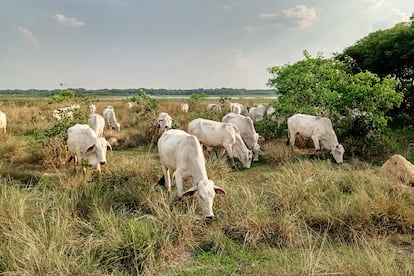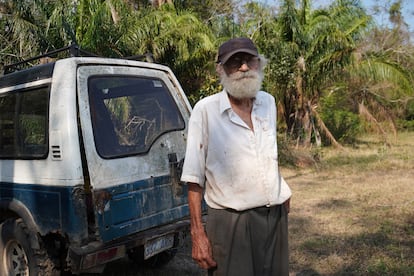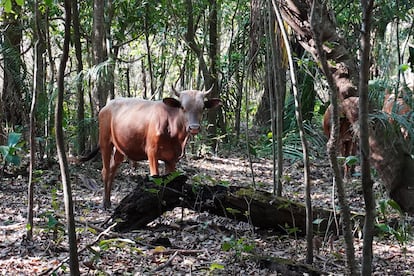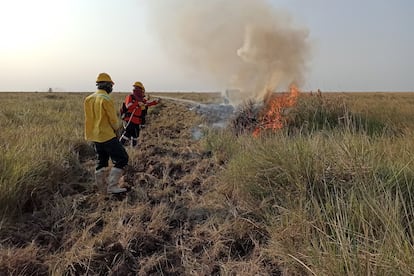Sustainable meat: Bolivia works to reform livestock operations that trigger deforestation
In the Andean country, forest loss has spread in parallel with the increase in beef exports. Some ranchers are now turning to practices that protect forests and long-term productivity

Sitting in the shade, Heinz Teetzen bites into a fresh watermelon to beat the heat. It’s a weekend in late September and, unusually for the beginning of spring, thermometers are rising to 41ºC (105ºF), with temperature alerts issued in seven of Bolivia’s nine departments.
This 86-year-old German, who has lived in Bolivia for more than 30 years, believes that the extreme heat is a consequence of the cutting down of forests to make way for agriculture and livestock. In fact, the Juan Deriba farm, owned by Teetzen, located 124 km (77 miles) from Santa Cruz, the largest city in the country, is a kind of island in the middle of large tracts of land planted mainly with soybeans and rice, but also full of cattle that graze on extensive grasslands.
Teetzen's concerns became more acute a few years ago. In 2019, Bolivia suffered one of the worst waves of forest fires in the decade due to factors such as the authorization of “controlled burns.” That year alone, 5.7 million hectares of forest burned, and the clearings are said to have been encouraged by the growing beef export market, including to China, which received its first shipments from Bolivia that year.

Deforestation in Bolivia has reached equally significant levels in recent years, driven by agricultural expansion and irregular confiscations of public lands, among other factors. But these losses have also prompted various organizations and individual ranchers to try to employ more sustainable livestock farming methods, which pursue forest-friendly practices while still being productive.
Record sales: a cause for concern?
Following a process of diplomatic negotiations and preparation to help Bolivian producers meet Chinese import requirements, the first shipment of 48 tons of beef to China was finally made in August 2019. Then-president Evo Morales described it as a “historical” event.
Since then, sales have broken records. From selling 1,174 tons of meat in 2012 for $6 million to other countries, Bolivia went on to sell 17,542 tons for a value of $82.5 million in the first six months of this year, 65% of it to China. This is shown by preliminary data from the Bolivian Institute of Foreign Trade (IBCE) to which the journalism platform Diálogo Chino had access. And in 2020, 84% of Bolivian production ended up in China.
Bolivia’s record sales have coincided with deforestation in recent years, mainly in Santa Cruz, the department where most of the meat destined for export comes from. In 2022, the country ranked third in the world in primary forest loss, with 385,000 hectares, only behind Brazil and the Democratic Republic of the Congo, a position it maintains in 2023.
Part of this loss has been supported by government policy: in July 2019, on the eve of the opening of exports to China, the Morales government promulgated the decree authorizing the clearing and “controlled burning” of forests for agricultural activities on private and community lands. However, this was repealed a year later by her successor, acting president Jeanine Áñez, during another wave of forest fires, but her new decree did not explicitly prohibit burning for agro-industrial purposes.
Despite alarming deforestation trends, the country continues to aggressively pursue its livestock goals. The objective of reaching two heads of cattle per inhabitant, compared to the current 0.9, is one of those defended by the Patriotic Agenda 2025, a document that establishes the economic and social guidelines for the year of the country’s bicentennial.
Sustainable and natural growth of livestock
Before Teetzen bought the 690-hectare Juan Deriba farm, it was exploited for felling timber trees. In the spaces that were deforested, a more sustainable type of livestock farming is now practiced. Teetzen says this method avoids the use of growth hormones on the animals and does not fatten them with special feed mixes in restrictive barns. The farm also rotates pastures to allow vegetation to regenerate.
This has allowed remnants of primary trees and large patches of secondary vegetation (Chiquitano and Amazonian forest) to be relatively well preserved in Juan Deriba, reads a study by the Noel Kempff Mercado Natural History Museum.
Teetzen began this practice after unsuccessful attempts to produce rice, soybeans, beans and corn without agrochemicals. At that time, in the late 90s, “there was no market for organic products,” he says. Instead, he decided to look for a method of raising livestock that would be productive and reduce environmental impact, starting with 40 head of cattle.
Today he has about 300 animals, including cows, steers and calves. They reach the internal market of Santa Cruz at a price similar to that of an animal raised in a traditional way: about 20 bolivianos (three dollars) per kilo, despite the fact that it costs more to raise them and requires significant additional effort. Still, Teetzen says it’s worth it, adding that he believes it’s best to take care of what little forest is left on his property.

The key difference between Teetzen's technique and traditional livestock farming is that his cattle take up to three or four years to reach maturity naturally, while others are ready for sale in two years because, as he explains, "they are fattened with hormones and balanced feed [composed of cereals and minerals], with sorghum, corn and soy, in closed stables.”
Animal rights groups have long believed that keeping and feeding cows indoors constitutes abuse and leads to increased incidence of disease transmission among livestock, as well as environmental damage.
Certify livestock reserves
In the Bolivian market, both traditionally produced and sustainably produced beef varieties ultimately enter the same production chain. While traditional livestock farming drives deforestation, for example, sustainable alternatives seek solutions and require greater effort to reduce environmental impact.
The Bolivian conservation organization Armonía aims to change this situation through certification, starting with the northeastern department of Beni, the second largest livestock producing area in Bolivia after Santa Cruz.
According to Tjalle Boorsma, Armonía's conservation director, the organization is currently “well on its way” to developing a model ranch in its Barba Azul Reserve. The reserve, created by Armonía in 2008, is the place where the organization applies experimental strategies for sustainable livestock farming in floodplains. Named after the blue-throated macaw native to the area, the Barba Azul Reserve is located in the heart of the Llanos de Moxos, an ecosystem of savannas and wetlands in the Bolivian Amazon, most of which is located in Beni.
The organization considers that its strategy is viable, since the Llanos de Moxos have never been deforested. Its ecosystem, described as a “flooded savannah” due to its seasonal flooding, is grassland interspersed with forests and dotted with small islands of forest and swamps.
The investigations of the Working Group for the Moxos Plains indicate that the “vast alluvial plains of the area offer abundant natural forage for animals and protected forest areas, while the season of floods and droughts give rise to a complex and difficult for production.”
The rotational management of cattle through different pastures so that they feed on native grass and the grass regenerates naturally, as well as the rational use of fire — because it is part of the ecosystem of the native pampas — have produced good results so far.
Likewise, small animal-friendly changes, such as having a square pen instead of a round one to reportedly reduce stress, or planned calving, which allows the cow to have a break to calve and not calve so frequently, as happens in traditional livestock farming, have also increased productivity, says Boorsma.

“An example is that, on traditionally managed farms, calf production is 50%. In our case, we are almost at 70%, just by applying a different type of management,” he says.
Once born, the calves are sent to fatten at the Laney Rickman Reserve, another location in Armonía, where the pastures are said to be more nutritious and fertile due to the location of the soil next to the Mamoré River. When the animals mature, those cattle are sold in Beni's capital, Trinidad. “Our cows will not go to Santa Cruz, where fattening is done on non-native pastures where there used to be Chiquitano forest,” says Boorsma. The organization is developing a sustainable meat certification for its livestock.
Regeneration of areas affected by deforestation
Meanwhile, in Roboré, a region of Santa Cruz greatly affected by fires and deforestation in recent years, the Chiquitano Forest Conservation Foundation (FCBC) is carrying out a regenerative livestock farming initiative.
Hermes Justiniano, supervisor of the PRIAS program (Innovative Regenerative Practices for Sustainable Agriculture) of the FCBC, explains that it is about putting emphasis on the biological part of the soil. To this end, we are currently working with 40 properties: 10 livestock and 30 agricultural, in four specific points: not using mechanized farming tools, keeping the soil always covered with some type of crop, maintaining plant diversification and not monoculture, and avoid agrochemicals.
In the case of livestock operations in particular, the fifth practice is to do intensive rational grazing or PRV (Rational Voisin Grazing), a technique that subdivides pasture plots to rotate the cattle, giving the opportunity for natural regeneration.
Justiniano talks about the benefits of this type of regenerative livestock farming: “If you do it well, you will have much higher productivity, and lower costs in pesticides and supplements.” In his opinion, this is “the only way” to maintain soil productivity without the need to deforest. Most farmers and ranchers, he says, “work the soil hard with plows, harrows, fertilizers and pesticides. Then, in five or six years, the soils are exhausted and they have to deforest more.”

More heat, less water
While the economic future is promising for Bolivia’s beef exports, it is not so promising for its environment. A recent study by the NGO Fundación Tierra warns that Santa Cruz will suffer higher temperatures and more extreme droughts due to agriculture and deforestation.
With the worsening effects of climate change, droughts are going to intensify, says Marlene Quintanilla, research director of the Friends of Nature Foundation (FAN). “The problem is becoming more visible this year because there is not enough forest to generate the humidity necessary for rain production,” he says. At the other extreme, he highlights that floods could present problems in the near future, even in areas where there are droughts today.
For all these reasons, Quintanilla urges politicians and companies to focus on science and research, pointing out that economic losses derived from droughts and floods already reach millions of dollars annually.
“There is a lack of planning for the coming years based on scientific and practical evidence to adapt to these changes,” he adds, such as water wells or facilities built to deal with major droughts. “The communities are suffering, but so are the producers, due to the loss of livestock and crops. We need to plan and join forces: companies, politicians, producers and governments.”
This article has been published jointly by América Futura and Diálogo Chino.
Sign up for our weekly newsletter to get more English-language news coverage from EL PAÍS USA Edition
Tu suscripción se está usando en otro dispositivo
¿Quieres añadir otro usuario a tu suscripción?
Si continúas leyendo en este dispositivo, no se podrá leer en el otro.
FlechaTu suscripción se está usando en otro dispositivo y solo puedes acceder a EL PAÍS desde un dispositivo a la vez.
Si quieres compartir tu cuenta, cambia tu suscripción a la modalidad Premium, así podrás añadir otro usuario. Cada uno accederá con su propia cuenta de email, lo que os permitirá personalizar vuestra experiencia en EL PAÍS.
¿Tienes una suscripción de empresa? Accede aquí para contratar más cuentas.
En el caso de no saber quién está usando tu cuenta, te recomendamos cambiar tu contraseña aquí.
Si decides continuar compartiendo tu cuenta, este mensaje se mostrará en tu dispositivo y en el de la otra persona que está usando tu cuenta de forma indefinida, afectando a tu experiencia de lectura. Puedes consultar aquí los términos y condiciones de la suscripción digital.
More information
Archived In
Últimas noticias
Most viewed
- Sinaloa Cartel war is taking its toll on Los Chapitos
- Oona Chaplin: ‘I told James Cameron that I was living in a treehouse and starting a permaculture project with a friend’
- Reinhard Genzel, Nobel laureate in physics: ‘One-minute videos will never give you the truth’
- Why the price of coffee has skyrocketed: from Brazilian plantations to specialty coffee houses
- Silver prices are going crazy: This is what’s fueling the rally










































